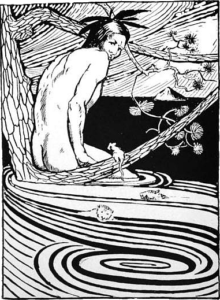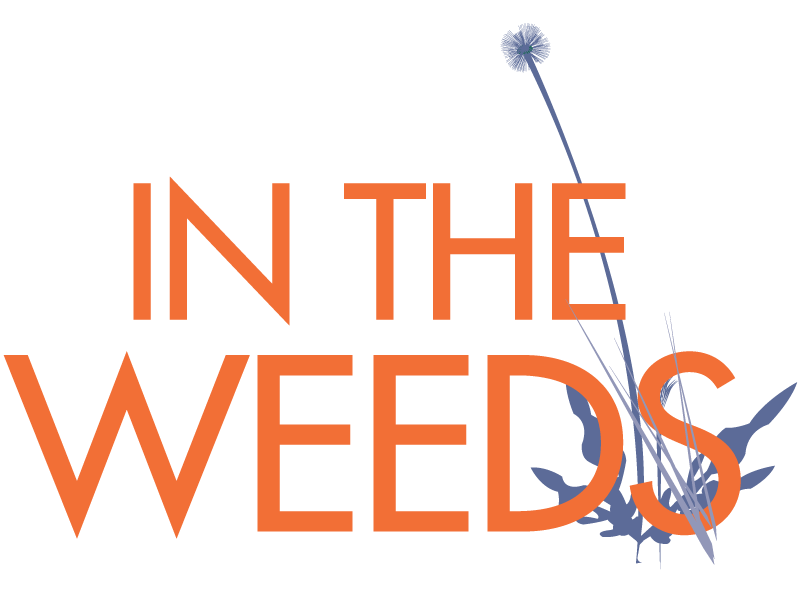
Illustration by R.C. Armour, from his book North American Indian Fairy Tales, Folklore and Legends, 1905
In Robin Wall Kimmerer’s deeply moving book, Braiding Sweetgrass, there is one chapter that speaks to a longing at once personal and endemic to our culture at large. In this chapter – entitled “In the Footsteps of Nanabozho: Becoming Indigenous to Place” – she uses the Anishibaabe story of the First Man, Nanabozho, to explore what it means to really belong to a place.
Her evocative phrase, “becoming indigenous to place,” speaks to an intimacy with the natural world that Nanabozho comes to embody. An “immigrant” at first, he explores Turtle Island, his new home, and gets to know all the creatures who inhabited it long before he arrived. As all intimacies do, this one emerges from a relationship, in this case one marked by receptiveness and learning and expressed through language. Kimmerer likens Nanabozho to an “Anishinaabe Linnaeus” who walks through the forest, naming plants and animals.
She uses this story to pose a question: given the profound disconnect with the natural world that marks American culture, would it be possible for Americans to “become indigenous to place,” to learn to be more like Nanabozho in his relationship to Turtle Island?
Not surprisingly, Kimmerer traces the problem we face back to the arrival of the Europeans:
After all these generations since Columbus, some of the wisest of Native elders still puzzle over the people who came to our shores. They look at the toll on the land and say, “The problem with these new people is that they don’t have both feet on the shore. One is still on the boat. They don’t seem to know whether they’re staying or not.” This same observation is heard from some contemporary scholars who see in the social pathologies and relentlessly materialist culture the fruit of homelessness, a rootless past. America has been called the home of second chances. For the sake of the peoples and the land, the urgent work of the Second Man may be to set aside the ways of the colonist and become indigenous to place. But can Americans, as a nation of immigrants, learn to live here as if we were staying? With both feet on the shore? (207)
It is in a passage like this one that I start to take Kimmerer’s philosophical musings personally. I have always been haunted by this question of what it means to have both feet in a place. In part, this is because I am decidedly of the immigrant class. Born in Zurich, Switzerland, of an American father and a French/German/ English mother who landed in Switzerland by circumstance at the age of 8 or 9 and then was stuck there, with a mother who didn’t speak the local language, after her father died suddenly of a brain tumor, I have always been a stranger with one foot in one place and one foot in another.
The words “stranger” and “foreigner,” appropriately, both derive from words that mean “outside,” as if to make it clear that to be a stranger is not merely not to belong but, in a sense, not to truly be in a place at all.
By contrast, the words “indigenous” and “native” both have their root in the fact of being born in a place, and yet, our way of speaking of “indigenous peoples” is enough to indicate that it isn’t enough for an individual to be born in a place to truly belong. So what does it mean to have both feet in a place? And can the immigrant ever truly belong?
For Kimmerer, “being indigenous” is manifest not only in an intimate knowledge of a place but in practices of respect and reciprocity. “Being indigenous to place” is rooted in behaviors – in listening, observing, learning, respecting and contributing something of one’s own gift. In this respect, one might suppose that any of us who took the time and the care to learn about the natural world we’re a part of and who engage in practices that respect the integrity of our local ecosystems could become “indigenous to place.”
But, for Kimmerer, it seems this project is ultimately futile: “Immigrants by definition cannot be indigenous. Indigenous is a birthright word. No amount of time or caring changes history or substitutes for soul-deep fusion with the land” (213). Ah! Yes, by definition, we immigrants are never quite at home in our new home. I understand what she means and yet I can’t pretend that it doesn’t hurt.
Again, I am taking her argument personally here, for better or for worse. A few years ago, I moved to a new place, which happens to be part of the “Maple Nation” Kimmerer calls home. I found myself disoriented when I first moved here, in part because it was also a move from the city to the suburbs. I knew I wasn’t home and yet I wasn’t sure where home was. What I needed, first, was simple to learn where I was.
I decided to enroll in a course on native plants and this did, indeed, give me a way in. It was the beginning of learning a new language, learning how to read the landscape around me, to get to know some of the fellow beings that inhabit this place.
It’s nice to imagine that if I get to know these beings well enough, I will have both feet in this new place and, yet, I know what Kimmerer means. I will never have the same soul-deep fusion with the land that she enjoys.
Kimmerer finds her compromise solution for the immigrant in naturalization; to be a naturalized immigrant she writes is to be like the common plantain (“White Man’s Footstep”), a plant that came from elsewhere but, unlike some of the other invasive plants, is not a bully. Her counter example is kudzu, the Japanese vine that smothers and kills large trees. Plantain, by contrast, brings with it a gift, its medicinal services.
Maybe the task assigned to Second Man is to unlearn the model of kudzu and follow the teachings of White Man’s Footstep, to strive to become naturalized to place, to throw off the mind-set of the immigrant. Being naturalized to place means to live as if this is the land that feeds you, as if these are are streams from which you drink, that build your body and fill your spirit. To become naturalized is to know that your ancestors lie in this ground. Here you will give your gifts and meet your responsibilities. To become naturalized is to live as if your children’s future matters, to take care of the land as if our lives and the lives of all our relatives depend on it. Because they do.
It’s hard to quibble with her argument. She is certainly right about our responsibilities to the land and, yet, as an immigrant several times over, I chafe a bit at all these distinctions that superimpose a political language – a modern, political language, moreover – onto our relationship with the places where we live.
Perhaps part of the problem is that it is not just we who are strangers but, increasingly, the land itself appears estranged from its own nativeness. As anyone who has studied native plants will know, many of our landscapes have been forever changed by the introduction of foreign species. So the problem seems doubled: we are outsiders trying to gain intimacy with a land that is no longer, in a sense, itself.
So where do we begin? I am inclined to think gently, and with humility. It is good to learn from teachers, like Kimmerer, who know the land and its inhabitants much better than I do. It is good to listen and observe and to think in terms of reciprocity. At the same time, it is impossible to think in absolutes. Like Nanabozho, in the story Kimmerer tells, we people are all immigrants at some stage in the story and it is good to have compassion for other immigrants, perhaps even for the kudzu that wants to blanket our forests. We are in a real sense strangers in a strange land and need to proceed with caution and care.
